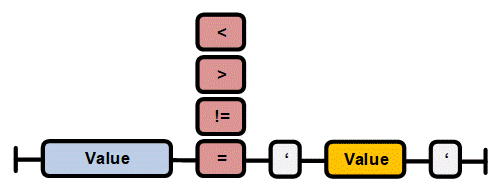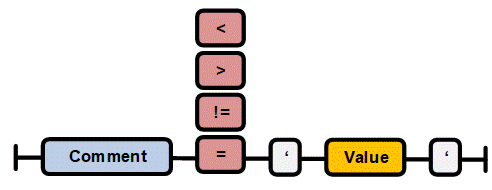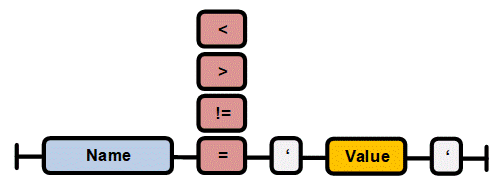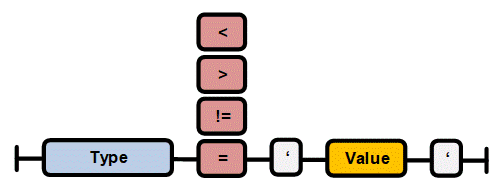Filter equation overview

A function is a subordinate quantity of functions, parameters, operators and value pairs. A function begins and ends with brackets (). Each function, parameter, operator and value pair is followed by a semicolon.
AND function
The AND function is used to filter for symbols whose conditions are satisfied by a TRUE. Two examples of the use of the AND function and in conjunction with the OR function are shown below.
AND ( Type = BOOL;
Name = 'bEnabled';
Value = True )The function filters for symbols with the type BOOL whose name is bEnabled and whose value is TRUE.
AND ( Name = nCounter;
OR ( Value = 10;
Value = 50 ))The function filters for symbols with the name nCounter whose value is '10' or '50'.
OR function
The OR function is used to filter for symbols where one condition is satisfied by a TRUE. Two examples of the use of the OR function and in conjunction with the AND function are shown below.
OR ( Value = 150;
Value = -150 )The function filters for symbols whose value is '150' or '-150'.
AND ( Name = 'nCounter';
OR ( Value = 10;
Value = 50 ))The function filters for symbols with the name nCounter whose value is '10' or '50'.
PARENT function
The PARENT function is used to filter for symbols whose direct parent symbol (higher-level symbol) is subject to an identical condition. The conditions specified in the PARENT function are logically ANDed.
 | The PARENT function can only be used in an AND function or in an OR function. |
Here is a general sample of the use of the PARENT function:
AND ( Name = 'sObjectName';
PARENT ( Name = 'Plant';
Value = TRUE ))The function filters for symbols with the name 'sSobjectName' and their parent symbol with the name 'Plant'. Furthermore, the value of this symbol must be TRUE.
ANCESTOR function
The ANCESTOR function is used to filter symbols whose ancestors in the parent chain of symbols are subject to a condition, e.g. a special name or type. The condition specified in the ANCESTOR function is logically ANDed.
 | The ANCESTOR function can only be used in an AND function or in an OR function. |
Here are some general examples of the use of the ANCESTOR function:
AND ( Name = 'sObjectName';
ANCESTOR ( Type = 'FB_BAC_AI'))The function filters for symbols with the name 'sObjectName'. The ancestors of these symbols come from the parent chain of symbols with the type 'FB_BAC_AI'.
AND ( Name = 'sObjectName';
ANCESTOR ( Name = 'Plant01'))The function filters for symbols with the name 'sObjectName'. Within the parent chain of these symbols, one of the ancestors bears the name 'Plant01'.
CHILD function
The CHILD function is used to filter symbols whose child symbols are subject to a condition. The conditions specified in the CHILD function are logically ANDed.
 | The CHILD function can only be used in an AND function or in an OR function. |
Here is a general example of the use of the CHILD function:
AND ( Name = 'Plant';
Child ( Name = 'sObjectName';
Value = 'P001' )Value Parameter
The function searches for symbols whose value satisfies a condition with a certain value.

Samples:
Value = '100'Search for symbols whose value is '100'.
Value > '100'Search for symbols whose value is greater than '100'.
Value < '100'Search for symbols whose value is smaller than '100'.
Value != '100'Search for symbols whose value is not '100'.
Value = ''Search for symbols whose value is empty ' '.
Comment Parameter
The function searches for symbols whose value satisfies a condition with a certain comment.

Samples:
Comment = 'Signal to detect'Search for symbols whose comment is 'Signal to detect'.
Comment != 'Signal to detect'Search for symbols whose comment is not 'Signal to detect'.
Comment >'Signal'Search for symbols whose comment begins with 'Signal'.
Comment < 'detect'Search for symbols whose comment ends with 'detect'.
Name Parameter
The function searches for symbols whose value satisfies a condition with a certain name.

Samples:
Name = 'bEnable'Search for symbols whose name is 'bEnable'.
Name != 'bEnable'Search for symbols whose name is not 'bEnable'.
Name > 'bEn'Search for symbols whose name begins with 'bEn'.
Name < 'le'Search for symbols whose name ends with 'le'.
Type Parameter
The function searches for symbols whose value corresponds to a condition of a certain type.

Samples:
Type = 'FB_BACnet_Pump'Search for symbols whose type is 'FB_BACnet_Pump'.
Type != 'FB_BACnet_Pump'Search for symbols whose name is not 'FB_BACnet_Pump'.
Type > 'FB_BACnet'Search for symbols whose name begins with 'FB_BACnet'.
Type < 'BACnet_Pump'Search for symbols whose name ends with 'BACnet_Pump'.
Attribute Parameter
The function searches for symbols that have an attribute whose name satisfies a condition with a certain value.

Samples:
Attribute = 'IsPersistent'Search for symbols that have an attribute with the name 'IsPersistent'.
Attribute != 'IsPersistent'Search for symbols that do not have an attribute with the name 'IsPersistent'.